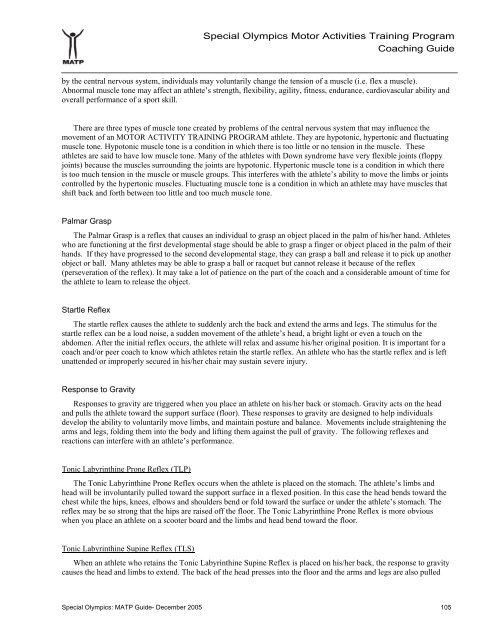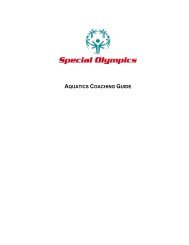MATP Coaching Guide - Special Olympics
MATP Coaching Guide - Special Olympics
MATP Coaching Guide - Special Olympics
You also want an ePaper? Increase the reach of your titles
YUMPU automatically turns print PDFs into web optimized ePapers that Google loves.
<strong>Special</strong> <strong>Olympics</strong> Motor Activities Training Program<br />
<strong>Coaching</strong> <strong>Guide</strong><br />
by the central nervous system, individuals may voluntarily change the tension of a muscle (i.e. flex a muscle).<br />
Abnormal muscle tone may affect an athlete s strength, flexibility, agility, fitness, endurance, cardiovascular ability and<br />
overall performance of a sport skill.<br />
There are three types of muscle tone created by problems of the central nervous system that may influence the<br />
movement of an MOTOR ACTIVITY TRAINING PROGRAM athlete. They are hypotonic, hypertonic and fluctuating<br />
muscle tone. Hypotonic muscle tone is a condition in which there is too little or no tension in the muscle. These<br />
athletes are said to have low muscle tone. Many of the athletes with Down syndrome have very flexible joints (floppy<br />
joints) because the muscles surrounding the joints are hypotonic. Hypertonic muscle tone is a condition in which there<br />
is too much tension in the muscle or muscle groups. This interferes with the athlete s ability to move the limbs or joints<br />
controlled by the hypertonic muscles. Fluctuating muscle tone is a condition in which an athlete may have muscles that<br />
shift back and forth between too little and too much muscle tone.<br />
Palmar Grasp<br />
The Palmar Grasp is a reflex that causes an individual to grasp an object placed in the palm of his/her hand. Athletes<br />
who are functioning at the first developmental stage should be able to grasp a finger or object placed in the palm of their<br />
hands. If they have progressed to the second developmental stage, they can grasp a ball and release it to pick up another<br />
object or ball. Many athletes may be able to grasp a ball or racquet but cannot release it because of the reflex<br />
(perseveration of the reflex). It may take a lot of patience on the part of the coach and a considerable amount of time for<br />
the athlete to learn to release the object.<br />
Startle Reflex<br />
The startle reflex causes the athlete to suddenly arch the back and extend the arms and legs. The stimulus for the<br />
startle reflex can be a loud noise, a sudden movement of the athlete s head, a bright light or even a touch on the<br />
abdomen. After the initial reflex occurs, the athlete will relax and assume his/her original position. It is important for a<br />
coach and/or peer coach to know which athletes retain the startle reflex. An athlete who has the startle reflex and is left<br />
unattended or improperly secured in his/her chair may sustain severe injury.<br />
Response to Gravity<br />
Responses to gravity are triggered when you place an athlete on his/her back or stomach. Gravity acts on the head<br />
and pulls the athlete toward the support surface (floor). These responses to gravity are designed to help individuals<br />
develop the ability to voluntarily move limbs, and maintain posture and balance. Movements include straightening the<br />
arms and legs, folding them into the body and lifting them against the pull of gravity. The following reflexes and<br />
reactions can interfere with an athlete s performance.<br />
Tonic Labyrinthine Prone Reflex (TLP)<br />
The Tonic Labyrinthine Prone Reflex occurs when the athlete is placed on the stomach. The athlete s limbs and<br />
head will be involuntarily pulled toward the support surface in a flexed position. In this case the head bends toward the<br />
chest while the hips, knees, elbows and shoulders bend or fold toward the surface or under the athlete s stomach. The<br />
reflex may be so strong that the hips are raised off the floor. The Tonic Labyrinthine Prone Reflex is more obvious<br />
when you place an athlete on a scooter board and the limbs and head bend toward the floor.<br />
Tonic Labyrinthine Supine Reflex (TLS)<br />
When an athlete who retains the Tonic Labyrinthine Supine Reflex is placed on his/her back, the response to gravity<br />
causes the head and limbs to extend. The back of the head presses into the floor and the arms and legs are also pulled<br />
<strong>Special</strong> <strong>Olympics</strong>: <strong>MATP</strong> <strong>Guide</strong>- December 2005 105
















